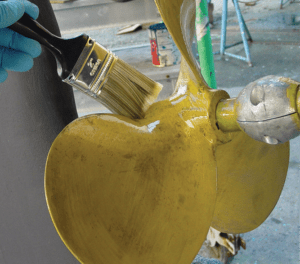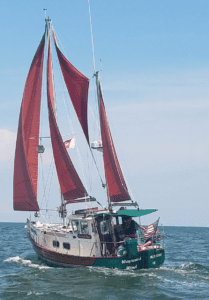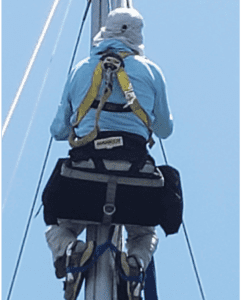DINGHY BEACH ROLLERS
Regarding your Inside PS blog, “Building a Better Boat Fender,” inflatable dinghy beach rollers also work great as fenders. They serve two purposes (if you also ever need a beach roller) and are very, very rugged (made for use on gravel beaches). But, the best part is they are fairly long so no fender board is needed when tied horizontally along the side of your hull.
Daniel Swords
Solitude, Alberg 30
Mandeville, Louisiana
CRYSTAL PROP

Could PS provide updated information on propeller antifouling products? I have used Prop Speed and other products, but none to date has really worked well for more than one season. I operate a Fisher motorsailer in the Chesapeake Bay. Recently, a sailboat from New Zealand anchored in front of my house, and its captain told me that he had been using a new product called Crystal Prop that he said worked very well on his propeller. I did some on-line research and found that this product appears to be made by Coverplast, an Italian firm. What can PS tell us about Crystal Prop and any other propeller antifouling products?
David Herndon
Wayward Wind, 1978 Fisher 37
White Stone, VA
We’ll look into Crystal Prop, which resembles other hard, slick coatings that we’ve tested with mixed results, including Prop Speed. We’ve found no U.S. distributor but will track it down.

THE TRUTH ABOUT DISSIPATORS
Regarding your blog post on lightning protection, (see PS Online, “The Truth About Dissipators,”) I witnessed my own boat being struck with lightning while moored in front of my home. It was a 34-foot sailboat in fresh water, without grounding, keel-stepped mast, external lead, fin keel, epoxy-coated. I was standing at the window watching the storm pass when I heard a “boom!” and saw a cascade of white hot sparks from the masthead as the windex and VHF antennae were vaporized. I waited for the storm to pass and rowed out to inspect the damage and found nothing! Electronics worked, even the radio fired up but obviously would not transmit or receive. I hauled the boat later in the week and found about one hundred little “craters” on the bottom that were the exit points of the strike. The craters only were as deep as the gelcoat and part way in to the mat skin coat. I ground them all out and filled, faired, and painted them. All was good after replacing the windex and VHF. I was lucky, I guess.
Ross Price
via PS Online
HARKEN BOSUN CHAIR

One issue I have with the Harken chair is that it slides back as I climb, whether I’m using ascenders or Prusik knots. The ATN chair has straps that secure the thighs to the seat; the Harken does not. Each time I stand up to climb, the Harken seat slips back up my butt, and when I then sit on the chair, I have to reach behind me and slip it forwards in order to sit on the seat comfortably.
Paul Alcock
Eximius, Catalina 34
Ft. Lauderdale, FL

Brighter, warmer days may seem far away in the northern regions of the planet, but spring sneaks up faster than we imagine, which means it’s time to start on that pre-
season to-do list.
- If you’re looking to upgrade deck hardware this year, there is a slew of related tests at www.practical-sailor.com.
— We evaluated snatch blocks in the July 2007 issue, looking at blocks from Antal, Garhauer, Harken, Lewmar, Schaefer, and Wichard. In the August 2008 issue, we featured a test update that put a line of blocks from Ronstan in the mix.
—Testers dove into the crowded world of shackles in the July 2014 issue. Now is a good time to inspect old shackles for signs of wear or failure, and to replace any that are questionable.
—If you’re upgrading your running rigging to high-tech lines, you’ll want to consider replacing your old rope clutches too. In the November 2014 issue, we reviewed a range of new rope clutches engineered to be grippier to handle today’s slick, high-tech fiber rope.
- If you unstep your mast each winter, it’s a great time to cleanup those halyards and sheets. Before you do, be sure to read our extensive report on washing ropes in the July 2011 issue. It answers those often-asked questions like whether you should use bleach or fabric softener; should they be laundered in a washing machine or bucket? The January 3, 2019 Inside Practical Sailor blog post offers a short recap of the article as well.
- Another chore you can cross off is cleaning—or clearing—foggy Eisenglass. In the May 2014 issue, we reviewed several products designed to clean or revive aged, clear-vinyl windows.
- Rewiring this winter? Check out our e-book series on electrical systems. The series includes volumes on batteries; electrical system installation (grounding and lightning protection); alternative energy; AC systems; and panels, charging, and monitoring. Check it out at our online bookstore at www.practical-sailor.com.








































